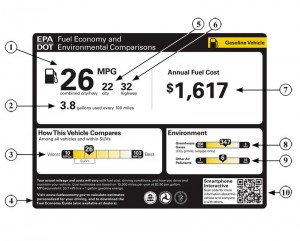
1. This vehicle can travel about 26 miles on a gallon of gas for combined city and highway driving. 2. This vehicle uses 3.8 gallons of gasoline to travel 100 miles for combined city and highway driving. This is an energy efficiency rate called fuel consumption. Fuel consumption values, unlike MPG, relate directly to the amount of fuel used. 3. This bar depicts the range of combined city and highway fuel economy for all labeled vehicles. The pointer shows where this vehicle is within the range of all vehicles and other vehicles in the same class as the labeled vehicle. 4. www.fueleconomy.gov will continue to provide consumers with a source of in-depth information. The website allows consumers to personalize estimates based on their own driving habits (i.e. annual miles traveled, local fuel cost, etc.). 5. This vehicle can travel about 22 miles on a gallon of gas for city driving. 6. This vehicle can travel about 32 miles on a gallon of gas for highway driving. 7. $1,617 is the estimated annual fuel cost based on a given number of miles and fuel price, which are listed lower on the label (15,000 miles per year and $2.80 per gallon for this example). 8. This bar depicts the range of the combined city and highway carbon dioxide (CO2) tailpipe emission rate for all labeled vehicles. The pointer shows where this vehicle is within the range. 9. This bar depicts the emission rating for vehicle tailpipe emissions that contribute to local and regional air pollution, creating problems such as haze and smog. The pointer shows where this vehicle is within the range. 10. A QR Code can be used by many Smartphones to access a web page, allowing consumers at a dealership to compare vehicles and personalize estimates, based on their own driving habits and fuel costs.
The U.S. Department of Transportation (DOT) and the U.S. Environmental Protection Agency (EPA) are jointly proposing the most radical changes to the fuel economy labels on the window of every new vehicle in dealer showrooms since the regulation began 30 years ago.
The stated goal of the new labels is to provide consumers with “simple, straightforward energy and environmental comparisons” across all types of vehicles, including electric vehicles (EV), plug-in hybrid electric vehicles (PHEV), and conventional gasoline-powered vehicles.
DOT and EPA said in a joint release this afternoon that they are looking to provide enhanced information on efficiency and environmental performance, including information about air pollutants, such as smog, that impact public health to consumers.
The Energy Independence and Security Act of 2007 passed under Republican President Bush specifically calls on EPA and DOT to rate available vehicles according to fuel economy, greenhouse gas emissions and smog forming pollutants.
“New technologies such as battery electric vehicles and plug-in hybrids are entering the American market in greater numbers,” said U.S. Transportation Secretary Ray LaHood. “We need to provide consumers with labels that include fuel economy and environmental information so that buyers can make better informed decisions when purchasing new vehicles.”
EPA and DOT are actually proposing two new label designs for comment during a rule making period that will be subject to intense behind the scenes lobbying by automakers in “pay to play” Washington. At stake is the stigma of a bad label on the side of a vehicle, which can cost makers sales and tarnish reputations.
One controversiallabel design prominently features a letter grade, A+ to D, to communicate the vehicle’s alleged overall fuel economy and greenhouse gas emissions performance. The new design will also provide consumers with an estimate of the expected fuel cost savings over five years compared to an average gasoline-powered vehicle of the same model year.
At first look the regulations appear to favor plug-in hybrids as the A+ label leaders, in keeping with politicians’ current favored technology. Critics of course say that the government should not be promoting design standards, relying instead on performance standards while letting technologies fight it out in the marketplace and giving consumers a choice.
The second proposed label retains the current label’s focus on miles per gallon (MPG), a demonstrable bad way of measuring fuel consumption when compared to gallons per mile. Also included would be the current annual fuel costs label, while updating the overall design and adding the required new comparison information on fuel economy and emissions.
Either way, both proposed labels expand on the current content by including new information on fuel consumption, tailpipe carbon dioxide (CO2) emissions and smog-related emissions. The new labels would also provide information on a new web-based interactive tool that can also be accessed by smart phone. This tool would allow consumers to personalize the information about a vehicle’s performance.
For electric vehicles and plug-in hybrids, the agencies want to show energy use by translating electricity consumption into a mile per gallon equivalent. The proposed label designs for EVs also include energy use expressed in terms of kilowatt-hours per 100 miles.
The proposed rule seeks public comment on label design options and related issues. The public can view the proposed rule and labels at: http://www.epa.gov/fueleconomy/ and submit comments as part of the rulemaking process via email to: newlabels@epa.gov. They can also review the proposed rule at http://www.nhtsa.gov/fuel-economy.
DOT and EPA are providing a 60-day public comment period that begins with the proposal’s publication in the Federal Register.
